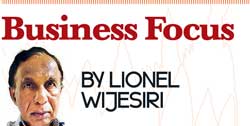30 Jan 2017 - {{hitsCtrl.values.hits}}

If you have gone through carefully the previous instalments, you would by now understand that business renewal is a judgment call—not a spreadsheet exercise. Your business model is the description of who your customers are, what they want from you, what you offer them and how you import/produce and charge for your products and services.
All companies have a business model, even if the executives, managers or workers can’t tell you what it is.
These business models must reflect the reality of where you are along the lifecycle curve. And at some point you will have to consider renewing all or part of your business. You can either make changes to your business and then figure out the impact on your business model or you can rethink your business model and design into it the changes necessary for renewal.
Your business model is a blueprint of who you want as customers, what you are promising them, how you fulfil your promises and how you will make money doing so.
Target customers 
Start your thinking by asking yourself what customers you need if your business is to succeed and what customers you should avoid. Success depends on customers with real wants and needs and the money to pay for your products and services. As for avoidance, ask any professional services executive about clients that are so much bother that they would like to get rid of them.
Another thing to consider is whether today’s customers fit the profile of the target customer you want and need in the future. In the early 2000s, auto companies loved all their SUV customers. Now they are fighting to find ways to make themselves relevant to buyers of smaller, fuel-efficient vehicles, customers whom they had spurned during the glory days of “bigger is better.”
Complete offering
Satisfying customer needs is more than putting your product or service in front of them. It consists of four interrelated components: your value promise, your relationship, your product or service and finally your communications.
Value promise
Your unique promise of value is a promise that you make to your target market that your brand will fulfil. Your promise of value is the essence of what you have to offer and guides you in how you live your personal brand.
It clarifies and communicates what makes you special - what makes you different from other people. Crafting this promise requires understanding your values, interests, strengths and personal qualities and using them to distinguish yourself.
Relationships
Why are relationships so important! The reason is tied to the issue of value promise. We like to buy from sellers we trust; we are more likely to trust sellers we know and who have delivered on their promises in the past.
Products and services
A promise is meaningless unless you deliver on it. And the only real judge of the success of this delivery is the customer. Your product may do everything your production engineers say it should but it must provide the benefits that your customers expect.
Communication
Real communication is both message and feedback. So, you should ask yourself: How do I know what our customers really expect of you?
The blogs today can move us much further toward powerful communication capabilities. They can lead to important conversations between sellers and the buyers. Or they can be a waste of valuable time as your workforce checks in several times a day to see what their kids are up to on their Facebook pages.
Competencies
Renewal strategies are built on the assets at your disposal. The possession of assets is a starting point but, in the end, it’s how you use them that will make a difference in the level of success your organisation achieves. Entrepreneurs are often asset poor so they make maximum use out of what they have.
Larger, well-established organisations are often asset rich but they sometimes squander them.
Look at the success of Indian airline - Jet Airways. What made them so good? Analysts attribute their success to a network of activities that made them unbeatable. Their value promise was to be the low-cost airline and all of their activities were aligned with that promise. (“Hi, we would love to serve food on our flights, but that wouldn’t make us the low-cost airline.”)
Jet Airways started its operations with leased aircraft because they found buying an aircraft would cost around US $ 50 million, whereas a monthly lease was as low as US $ 0.4 million. They started with the new Boeing 737-300s and not the older Boeing 737-200s because new model was fuel-efficient and cheaper to maintain. They bought only one type of aircraft, which ensured maintenance and flight crew training was simple. Another reason for the success of Jet Airways was its lean structure. Compared to Indian Airlines’ 397 employees per aircraft, Jet Airways had only 163 employees per aircraft.
Target customers
How do you get your products and services to your target customers? Do you go to them or do you make them come to you? Furthermore, how do your target customers want you to distribute your goods and services?
Remember long ago when ATM machines were new? Many of the bank’s best customers saw no need for them because they wanted to talk to a “real person”. Now fast forward to today - would you even think of working with a bank that did not have a great ATM network? Customers have come to expect ATMs despite their previous resistance.
Often executives limit their thinking to their current, in-house capabilities. This is too narrow a point of view. All companies need suppliers, alliances and partners of various sorts to succeed. Selecting the best partners to work with you is paramount to your success.
Toyota’s rise to dominance in the 1980s was built on a network of suppliers that allowed it to implement what, at that time was an earth-shattering innovation - just-in-time manufacturing. That innovation changed the face of manufacturing across every industry.
Rules, beliefs and norms
Every organisation plays by a set of rules, some stated and some implicit. For example, all organisations need to bring in more revenue than they expend in costs. A company run for profit must realize significant goals not merely for revenue but for its bottom line.
Here are some other questions you should ask yourself about your company’s rules, beliefs and norms: How do you treat your employees? Do you consider them to be partners? What does the word “ethics” mean in your organisation? How far will you stretch your principles to make a profit? Is the customer your number one consideration? What’s your attitude toward risk?
The answers to these questions will determine how you conduct your business model in the real world.
Evaluating your willingness to change
At this point, you must ask yourself: “Given our history, culture, market position and business processes, can we ‘make it happen’?
Go back to the list of things you can change. Now ask if there are items and categories that have such a strong emotional or cultural tie to your organisation that you will be unable (unwilling) to change them.
Customers: Would we be willing to abandon our best customer?
Products and services: Is our current product or service our business identity? How much leeway will our customers give us if we choose to make a change?
People and organisation: Could we leave our team behind and start over with new people! Do we have the desire and energy to build a new organisation?
Resources: Could we demolish our original factory?
Location: Would we move to another neighbourhood? Another district?
Information and communication technology: Could we give up the ‘tried and true’ for leading-edge technology!
Policies and procedures: Are we willing to admit there are better ways?
Metrics: How focused are we on financial results versus other important metrics of performance?
Suppliers: Can we leave our oldest friend in the industry?
Competitors: Are we willing to consider that there are new (and better) competitors?
(Lionel Wijesiri is a retired corporate director counting three decades of senior management experience. He is now an independent consultant and a freelance journalist. He may be contacted on [email protected])
09 Jan 2025 4 hours ago
09 Jan 2025 5 hours ago
09 Jan 2025 8 hours ago
09 Jan 2025 8 hours ago
09 Jan 2025 9 hours ago